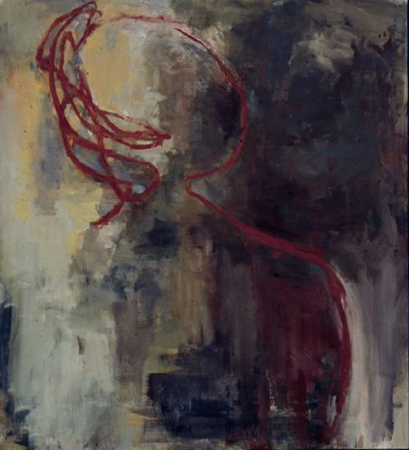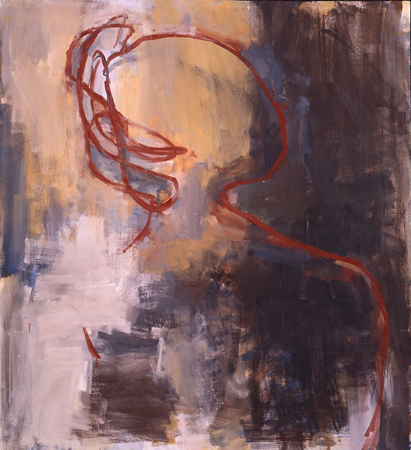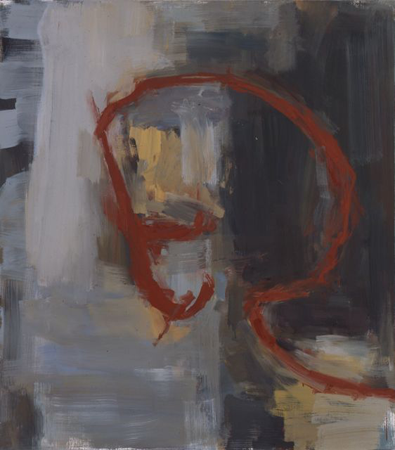Essay
Mark Staff Brandl
When a myth or belief is no longer accepted as a literal account, whether due to a period of crisis or cultural transition, it may be recast in a new form, humanizing and assimilating more primitive dimensions by the symbolic and evocative nature of metaphor. The primary symbols of a culture are then perceived and colored by the individual consciousness receiving a specific complexion over long periods of time, and their multiple, often subtle, meanings lend themselves to those religious and poetic usages whose function is to establish man's meaningful existence in a seemingly indifferent world.1
Th. Emil Homerin
The new paintings of Lex Braes are at a stroke enticing and disquieting. While one is enjoying their painterly flourishes and overall visual richness, certain quandaries come to mind. Are his pieces fully nonrepresentational or not? Do they court or resist the temptation one feels to read allusions into them? What is the nature of his seemingly contentious relationship to the history of expressive brushstroke? Demanding such willed duality is the artist's forte. Braes's works raise difficult questions, requiring time to sit in front of the paintings in order to contemplate possible answers. When thus allowed to work slowly on the viewer, when one is still, the pieces unfold as the intended location of precisely these ambiguities.
All the problems offered in these paintings are inherent to the practice of painting, to the creation of art. Art itself, as its best, is questions. The principal challenge Braes puts to himself is key to our time: how can we, standing among the remains of Modernism and Postmodernism, pick up and go on. What is there still to do.
We are in a period of transition, much as the Mannerists were in the mid 16th century. Loomed over by the great figures of the self-secure Renaissance, they sought no reassemble and distort the vestiges of that tradition. They created works cacophonic, capriciously novel, dominated by crisis and inner contradiction, yet often startlingly original. The inherited elements of their thought were put together in stretched complex fashions, seldom fusing into harmonious whole. Finally by dynamic naturalization, theatricality, and an "ensemble" approach the distortion was made internally consistent - health as it were - thus becoming the Baroque. This is an uncannily appropriate description of the present as well.2
The unabashed presence of painterly brushstrokes strikes the eye immediately when viewing Braes's work. Nevertheless, his manipulation of material - the traditional oil on canvas - is extremely self-aware. The paint stroke is a given, obviously inherited from an over-used and then prematurely abandoned direction of High Modernism. Braes does not perpetuate this technique unquestioningly. He incorporated our doubt while pushing forward. He is thinking in paint, not displaying what the material does, al lowing the viewer to see concrete evidence of a thought process, not remains of emotional hesitancy. His paintings are consciously post-avant garde. Whether they are Post-Modern, Postmodern or even Post-Postmodern, they describe the desire to reach the next, psychologically integrated stage - our Baroque. Braes practices a dialectical misprision of his (treasured) Action painting forebearers. One that has similarity to most jazz musicians' attitudes toward tradition.
They simultaneously pay homage to, analyze and comment on their predecessors, refusing simplistic Oedipal denials of the "father" as are common in contemporary visual art. Cultural theorist Cornel West describes the musical creativity of Charlie Parker as "subversive virtuosity" an apt phrase I would like to borrow for Braes's engagement with paint.3
Much of Braes's individual power results from the hauntingness of faint suggestion, as critic Janet Koplos has astutely pointed out. She says that in his paintings "figuration resists abstraction." Asking of one image if it is "a ghost or a memory" or simply "a fortuitous fall of paint."4 In the paintings since those she reviewed, Braes has been simplifying his surfaces, while increasing their richness through broader conflicts among areas and passages of different handling. There is an ever stronger competition between figure and ground, between what we should perceive as each, and how they are applied. The confounding of an image has=2 0moved away from his previous screen-like effect and stretched to the conceptual level. There is less uniformity of effect, more "vulnerability," a word Braes often uses. The artist bends painting by pairing its elements in associatively enigmatic contraries, within the received notion of a discipline in crisis. What is to be done with the shards, the incomplete fragments of painting - by allusion, of course, of like itself?
Is there anything to celebrate? Can strength be created from vulnerability? Must crisis result in glittering zombies of nihilism? Not for this artist. He is devoted to locating an "inner necessity - a new healthiness", the only worthwhile goal for art according to Kuspit.5 this is dynamic balance, soundness as a choice, as a still tension. Walking on a mountain ridge without falling off either side into the ease of Sophistry or elegance.
Braes's newest paintings, titled the Still series, include four major works 78in. x 70 in. (198 x 178cm) and several smaller but equally impressive ones. The tangles, traveling Pompeii red line of his Dreamer series is now comprised of several reds combining into an earthy terracotta. This fore fronted brushy meander conjoins a Philip Guston-like crudeness with the variations of speed in Zen painting. I can almost picture Braes grunting in imitation of growth as my sumi-e teacher did while painting trees. The image derives from a small outline drawing of the head and shoulders of a person, in which the figure's right has been vigorously reworked until the uncertain over markings approximating the form begin to resemble a robust Celtic tracery.
But in these painting it is not clear whether the hint of a "figure" is aimed full-frontally at us or is looking away, granting us an over-the-shoulder shot of the "background." I place both these words in scare quotes to indicate their contingency. The red stroke is off to the left in many of the works, most pronouncedly in Number 3, thus granting the background the major role. Painted as a mass of blocky passages, it surrounds, penetrates, and contrasts dramatically with the red outline. Opening vistas of light and air, the surround denies the inviolability of the figure while strengthening the symbolic unity of the two opposed elements. Number 2 plunges most of the line into darkness while haloing the festooned section with light. The natural colors Braes uses seem strangely contradictory. The grey is warm yet could be the patina on a concrete wall. The yellows are cool, yet with the heartening effect of an opalesque dawn. The browns and oranges seem forlornly fleshlike. In the smaller works the red stroke stays the same size as it is in the larger ones, therefore assuming a greater proportional breadth and scale. These painting have the impact of portraits and a flavor of what is termed an apostrophe in poetics - a direct address to the viewer.
One is tempted to see movement and consecutiveness from one painting to the next through the series, as if they were related to comic strip, panels, film storyboards, or movie stills. The progression can be read as a series of alternate takes, or possibilities for the viewers to edit potential sequences individually in their heads. Is the cool yet refreshing yellow a light advancing from the distance, or is it receding, being enveloped by the scratchy fleshy brown? Braes's work permits both readings.
From the nuts-and-bolts dichotomy of paint handling vs. composition, to the larger questions of doubting painting vs. celebrating it, Braes's art struggles with establishing a new ground for entering painting back into the contemporary philosophical discourse about art. More remarkable, though, is that Braes's equivocalities in suspension are pregnant with application to our life experiences as well as to art, vindicating our sense of anomalous yet sound individuality. He offers a reimaging of true, contradictory and uncompliant selves in the mesh of inherited and created identities in our period of cultural transition. This is making a meaningful existence in paint. Still.
Mark Staff Brandl
St. Gallen, Switzerland, 1997
- The Emil Homerin "Echoes of a Thirsty Owl: Deaths and Afterlife in Pre-Islamic Arabic Poetry" Journal of Near Eastern Studies 44, no.2 (1985):174
- I am developing this idea extensively in an article to be published later this year.
- Cornel West, beyond Eurocentrism and Multiculturism 2 Vols. (Monroe, Maine: Common Courage Press, 1993), vol.2
- Janet Koplos, Exhibition Review, Art in America July 1992
- Donald Kuspit, Idiosyncratic Identities (Cambridge: Cambridge Univ. Press 1996) p.16





